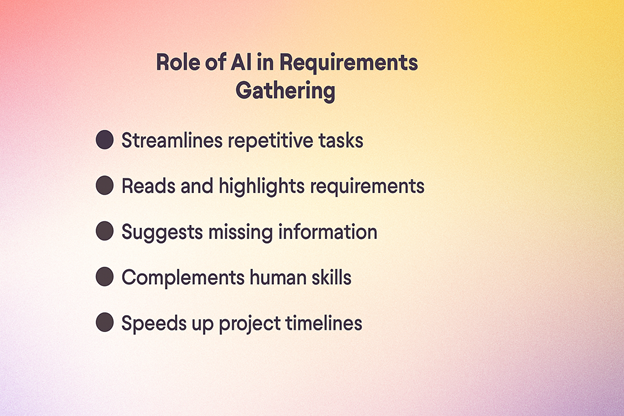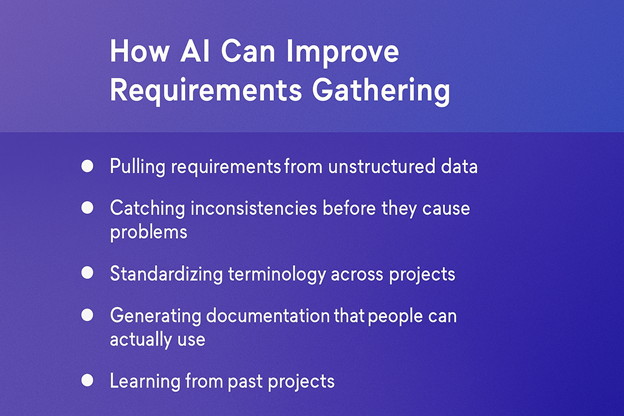>>
Technology>>
Artificial intelligence>>
How AI Revolutionizes the Requ...How AI Revolutionizes the Requirements Gathering Process?
The Silicon Review
22 October, 2025
Gathering requirements never feels tidy. One meeting turns into five. Notes go missing. You think something's decided, and a week later it's not. Developers start work with half the information, and testers scramble to figure out what the feature was even supposed to do. This is where most projects fall apart. Not in the middle, but right at the beginning, because no one was completely clear on what the goal was. Teams that bring in AI for requirements engineering are trying to clean this up. They're not using it to replace thinking. They're using it to pick up what people miss. A good tool for requirements gathering can scan all the calls, all the emails, all the random Slack messages, and pull out the stuff that matters. It's not magic. It just saves people from spending hours sorting through chaos.
Role of AI in Requirements Gathering
Traditional requirements gathering is slow. It means long meetings, dozens of interviews, and endless documentation reviews. Analysts spend days piecing together what people actually said, trying to make sense of incomplete thoughts.
AI takes over the repetitive part of that work. Natural language processing can read transcripts, emails, and chat messages, then highlight actual requirements hidden in everyday conversation. Machine learning can recognize patterns from older projects and suggest what might be missing this time.
This does not replace people. It just removes the most exhausting parts of the job so analysts can focus on what only humans can do: validation, prioritization, and communication. Projects that use AI for requirements gathering usually finish this stage faster and make fewer mistakes later.

How AI Can Improve Requirements Gathering
When teams start using AI to gather requirements, the changes show up quickly. Tasks that used to take weeks can be done in hours. The output is clearer and more complete. Analysts can see gaps that would otherwise go unnoticed.
Pulling Requirements from Unstructured Data
Stakeholders rarely provide clean input. Important details are scattered across emails, meetings, and chat messages. AI reads through all of that material, looks for intent, and extracts the real requirements. It spots things like dependencies, constraints, and user needs that people mention casually but never write down.
QA teams benefit directly because when requirements are captured consistently, the software is tested against the right expectations. Nothing critical slips through the cracks.
Catching Inconsistencies Before They Cause Problems
Large requirement documents often contradict themselves. One page says users must log in, another says the opposite. These issues only show up once developers start building, and by then they are expensive to fix.
AI reviews the text automatically and flags conflicts or vague language. It identifies where two requirements cannot coexist or where something is unclear. Analysts get a list of problem areas before the coding even begins. That early feedback saves time, money, and stress.
Standardizing Terminology Across Projects
Every team ends up creating its own mini-dictionary. Marketing calls something a dashboard, developers call it a metrics view, and product calls it an analytics screen. Everyone is talking about the same thing but using different words.
AI spots those overlaps. It can tell when several terms mean the same feature and recommend a single version to keep things consistent. Once the terminology is unified, the communication improves, documents become easier to read, and confusion fades. Distributed teams benefit the most because they no longer need to guess what others meant.
Generating Documentation That People Can Actually Use
Documentation is one of the biggest pain points in requirements work. It takes hours to write, days to review, and often becomes outdated within a month.
AI automates the formatting and organization. It groups related items, applies consistent structure, and keeps everything current as changes come in. Analysts still decide what matters, but they no longer spend their time fixing formatting or hunting through old versions.
The documents stay relevant because they evolve as the project does. Teams can trust what is written instead of ignoring it after version one. Developers, testers, and managers all use the same updated reference, which keeps everyone aligned.
Learning from Past Projects
Every project leaves behind lessons, but most teams move too fast to capture them. A feature that caused delays, a client request that kept changing, a dependency that broke under pressure; all of it holds value. Yet once the release is done, that experience fades into meeting notes and emails that nobody opens again.
AI changes that. It can scan past projects, trace how requirements evolved, and spot where things went off track. If a new project starts to follow a familiar pattern, the system quietly raises a flag. It might notice that similar features caused integration issues before or that a certain requirement usually leads to late revisions. That kind of gentle reminder helps teams act early instead of repeating the same mistakes.
This becomes especially powerful for companies that work on similar products over time. Whether it is new e‑commerce sites, mobile apps, or enterprise dashboards, AI becomes the quiet observer that remembers what the team has already learned and makes sure that knowledge is never lost between handoffs or staff changes.

Conclusion
AI in requirements gathering is not about replacing people; it is about letting them do the work that matters. Instead of spending days rewriting notes or sorting through half‑finished specifications, teams can focus on clarity and intent.
Machines handle the grind: reading, comparing, organizing. Humans handle the meaning: asking questions, confirming details, making decisions. Together, that mix produces cleaner requirements, faster development, and fewer surprises.
Teams that adopt AI in requirements engineering see real improvements in communication and output. They understand what is being built and why. They deliver software that matches user needs instead of guessing at them. And with the right requirements engineering tool, that understanding becomes repeatable — a framework teams can rely on every time they start something new.
_2025-12-15_12-44-58.webp)


_2025-11-17_06-38-14.webp)

 (1)_2025-10-21_13-35-14.webp)
